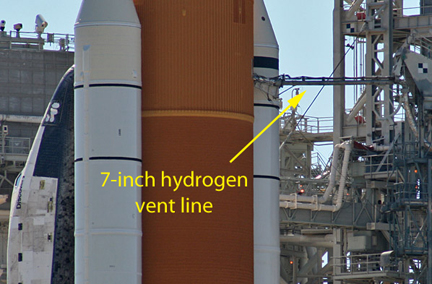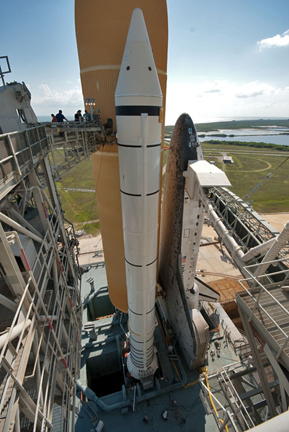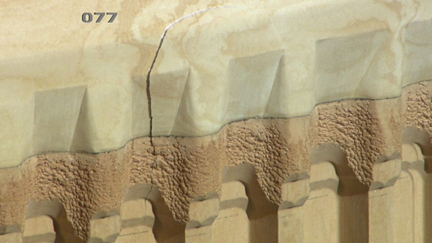Engineers mull shuttle repair options
By WILLIAM HARWOOD
CBS News
KENNEDY SPACE CENTER, FL--Engineers extended a launch pad access platform Monday in preparation for inspections and disassembly of a 7-inch hydrogen vent line quick-disconnect fitting to find out what caused a potentially dangerous leak that forced NASA to cancel the shuttle Discovery's planned launching last Friday.
Initial troubleshooting is expected to begin Tuesday. While it is not yet clear what might be needed to fix the problem, engineers may carry out a fueling test, exposing the vent line hardware to cryogenic conditions, before another launch attempt is made. In the meantime, the flight is on hold until at least Nov. 30.
In parallel with the vent line investigation, shuttle managers also are refining plans for repairing cracked foam insulation on Discovery's external tank that was discovered after Friday's launch scrub was declared.
The cracks are believed to have formed shortly after 7 a.m. EDT Friday, about an hour after engineers begin pumping supercold liquid oxygen and hydrogen rocket fuel into the huge tank and just before the vent line leak developed. The longest single crack measures almost four feet long, end to end, in an area measuring about 10 inches by 20 inches.
Access at the pad is difficult, but technicians tentatively plan to begin cutting away foam in the damaged area Wednesday, using non-destructive evaluation to look for signs of any problems with the underlying metal might explain the cracking. A repair plan will not be approved until after the foam in the damaged area has been "dissected" and engineers get a better idea of what caused the problem in the first place.
Foam repairs are not unusual, but they are normally carried out in a controlled environment inside the cavernous Vehicle Assembly Building. At the pad, protective covers will be needed to control humidity and temperature before any foam spraying and shaping can be carried out.
Discovery's launch on an 11-day space station resupply mission, the orbiter's 39th and final flight, originally was planned for Monday, Nov. 1. But it was delayed two days to replace suspect quick-disconnect fittings in the pressurization system of the shuttle's right-side orbital maneuvering system rocket pod.
A launch attempt last Wednesday was called off because of a subtle electrical issue and bad weather prompted NASA managers to call off an attempt last Thursday.
Launch now is on hold until at least Nov. 30, the opening of the year's final shuttle launch window. Taking advantage of the delay, engineers also plan to replace a suspect circuit breaker in the shuttle's cockpit that may be responsible for the electrical irregularity observed last week.
The vent line is used to carry excess hydrogen gas away from the shuttle as the tank is filled with super-cold propellant. During fueling, a valve is opened periodically to route hydrogen to the vent line as required to maintain the proper pressure in the tank. The excess gas is carried to a nearby "flare stack" where it is burned off. Just before launch, the vent valve is closed and the tank is pressurized for flight.
The vent line attaches to a port on the side of the external tank with a complex quick-disconnect fitting known as a ground umbilical carrier plate, or GUCP. At launch, an explosive charge fires, the quick-disconnect fitting separates and counterweights quickly pull the vent line down and out of the way.
The vent line attachment fitting on the left side of Discovery's external tank met specifications and passed pre-fueling tests, using helium at room temperature as a stand in for gaseous hydrogen. But during fueling Friday, sensors indicated a massive leak near the quick-disconnect fitting, presumably the result of temperature-induced effects on the hardware.
Engineers later said the leak rate was the highest ever seen in that area.
Because of the size of the leak -- well above the 6 percent concentration that is the maximum level read by launch pad sensors -- engineers are hopeful some sort of obvious defect will be apparent when the hardware is disassembled and inspected. But others are not so optimistic.
While the vent line fitting in question met specifications, a key component was slightly more out of round than usual. Whether that can explain the problem or not remains to be seen, but the fitting met stringent alignment specifications before fueling and passed all of its normal leak checks.
Problems with hydrogen leakage in the GUCP delayed two shuttle missions in 2009. In the most recent previous leak, the shuttle Endeavour was grounded June 13 and 17, 2009, when sensors near the umbilical attachment plate detected hydrogen concentrations of more than 6 percent.
After the second launch scrub, engineers collected detailed measurements and concluded the problem was caused by an alignment issue between the hydrogen vent port on the tank and the vent line interface. To ensure a tight fit, engineers replaced a rigid Teflon seal with a more flexible design, modified the umbilical plate mounting pins and installed washer-like shims to counteract the alignment issue.
The shims provided additional pressure on one side of the attachment fitting that was believed to be pulling away slightly as the hardware contracted under cryogenic conditions.
The fix worked, Endeavour was safely launched in July 2009. No other GUCP problems occurred before Discovery's fueling Friday.
CBS News
KENNEDY SPACE CENTER, FL--Engineers extended a launch pad access platform Monday in preparation for inspections and disassembly of a 7-inch hydrogen vent line quick-disconnect fitting to find out what caused a potentially dangerous leak that forced NASA to cancel the shuttle Discovery's planned launching last Friday.
Initial troubleshooting is expected to begin Tuesday. While it is not yet clear what might be needed to fix the problem, engineers may carry out a fueling test, exposing the vent line hardware to cryogenic conditions, before another launch attempt is made. In the meantime, the flight is on hold until at least Nov. 30.
 |
| A 7-inch gaseous hydrogen vent line attached to the side of the shuttle Discovery's external tank. A leak in or near the attachment fitting delayed a launch attempt last Friday. (Photo: Spaceflight Now/Justin Ray) |
In parallel with the vent line investigation, shuttle managers also are refining plans for repairing cracked foam insulation on Discovery's external tank that was discovered after Friday's launch scrub was declared.
The cracks are believed to have formed shortly after 7 a.m. EDT Friday, about an hour after engineers begin pumping supercold liquid oxygen and hydrogen rocket fuel into the huge tank and just before the vent line leak developed. The longest single crack measures almost four feet long, end to end, in an area measuring about 10 inches by 20 inches.
Access at the pad is difficult, but technicians tentatively plan to begin cutting away foam in the damaged area Wednesday, using non-destructive evaluation to look for signs of any problems with the underlying metal might explain the cracking. A repair plan will not be approved until after the foam in the damaged area has been "dissected" and engineers get a better idea of what caused the problem in the first place.
 |
| Workers can be seen on an access arm (upper left) used to prepare the hydrogen vent line after Discovery's rollout to the launch pad in September. (Photo: NASA) |
Discovery's launch on an 11-day space station resupply mission, the orbiter's 39th and final flight, originally was planned for Monday, Nov. 1. But it was delayed two days to replace suspect quick-disconnect fittings in the pressurization system of the shuttle's right-side orbital maneuvering system rocket pod.
A launch attempt last Wednesday was called off because of a subtle electrical issue and bad weather prompted NASA managers to call off an attempt last Thursday.
Launch now is on hold until at least Nov. 30, the opening of the year's final shuttle launch window. Taking advantage of the delay, engineers also plan to replace a suspect circuit breaker in the shuttle's cockpit that may be responsible for the electrical irregularity observed last week.
The vent line is used to carry excess hydrogen gas away from the shuttle as the tank is filled with super-cold propellant. During fueling, a valve is opened periodically to route hydrogen to the vent line as required to maintain the proper pressure in the tank. The excess gas is carried to a nearby "flare stack" where it is burned off. Just before launch, the vent valve is closed and the tank is pressurized for flight.
The vent line attaches to a port on the side of the external tank with a complex quick-disconnect fitting known as a ground umbilical carrier plate, or GUCP. At launch, an explosive charge fires, the quick-disconnect fitting separates and counterweights quickly pull the vent line down and out of the way.
The vent line attachment fitting on the left side of Discovery's external tank met specifications and passed pre-fueling tests, using helium at room temperature as a stand in for gaseous hydrogen. But during fueling Friday, sensors indicated a massive leak near the quick-disconnect fitting, presumably the result of temperature-induced effects on the hardware.
Engineers later said the leak rate was the highest ever seen in that area.
Because of the size of the leak -- well above the 6 percent concentration that is the maximum level read by launch pad sensors -- engineers are hopeful some sort of obvious defect will be apparent when the hardware is disassembled and inspected. But others are not so optimistic.
 |
| A crack in the foam insulation of the shuttle Discovery's external tank was found after launch was called off Friday due to a hydrogen vent line leak. (Photo: NASA) |
Problems with hydrogen leakage in the GUCP delayed two shuttle missions in 2009. In the most recent previous leak, the shuttle Endeavour was grounded June 13 and 17, 2009, when sensors near the umbilical attachment plate detected hydrogen concentrations of more than 6 percent.
After the second launch scrub, engineers collected detailed measurements and concluded the problem was caused by an alignment issue between the hydrogen vent port on the tank and the vent line interface. To ensure a tight fit, engineers replaced a rigid Teflon seal with a more flexible design, modified the umbilical plate mounting pins and installed washer-like shims to counteract the alignment issue.
The shims provided additional pressure on one side of the attachment fitting that was believed to be pulling away slightly as the hardware contracted under cryogenic conditions.
The fix worked, Endeavour was safely launched in July 2009. No other GUCP problems occurred before Discovery's fueling Friday.